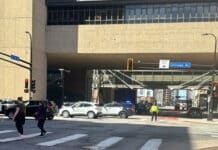Residents and leaders in the Southeast Como neighborhood of Minneapolis’ 2nd Precinct are raising new concerns about police response times amid increasing development and neighborhood population growth.
The concerns are detailed in a new report by the Minnesota Daily that says over the last six months residents have alerted the neighborhood association to several incidents where residents waited between 30 minutes and an hour for police to respond to their 911 calls.
In one incident an elderly woman had fallen inside her locked home and waited an hour for police to arrive and assist with entry so the other first responders on site could gain entry. First responders need to wait for police before forcing entry, per policy. In another incident a woman called police after a man exposed himself to her while she was walking in the neighborhood. Police didn’t arrive until 30 minutes later and were unable to locate the man at the time. In another incident a woman arrived home to find her door kicked in and waited 45 minutes for police to arrive.
Minneapolis City Council Ward 2 representative Cam Gordon, whose district covers parts of the 2nd Precinct including Southeast Como, said that the city does not have a clear policy to determine MPD officer placement within the city and he said that staffing the 2nd Precinct can be challenging. Gordon said he supports the case for more officers in the 2nd Precinct, suggesting the possibility of moving officers from another precinct, the report said.
The 2nd Precinct is one of the largest geographic precinct areas in Minneapolis covering an area from the Columbia Heights border on the north to the Mississippi river along the west and south borders, through the University of Minnesota campus and nearly to Hwy. 280 at the St. Paul border on the east.
Southeast Como neighborhood association board members also expressed concern that the city hasn’t kept up with a proportional response in resources based on the area’s increasing development the report said.
At least three large-scale developments are planned or in the works for the southeast Minneapolis area including a 25-story mixed use commercial and residential development in Dinkytown, a six-story 112 room extended stay hotel in Prospect Park, and under construction is the Expo at 200 University Avenue Southeast, a 26-story commercial and residential complex covering an entire city block. Several multi-unit residential projects are also planned or are under construction in the northeast Minneapolis portion of the 2nd Precinct.
Concerns about police response time were also raised in July when data was revealed showing that over 6,700 priority one 911 calls had gone without an immediate police response from July 2018 through June 2019. Priority one calls are situations where there is an imminent threat to personal safety, or the loss or damage to property exists, or where conditions at the scene of the call are unstable. The Star Tribune reported in March after an analysis of 2017 data on 911 calls that areas of Minneapolis were experiencing median response times from 7 minutes to 14 minutes, depending on location.
Police response time concerns are not a new issue in Minneapolis. In 2016 the Minneapolis City Council raised questions about police response time when it was reported that response time increased from 9 minutes to over 12 minutes in one precinct, and response times in other precincts had increased by about one minute. In 2012 the average police response time across Minneapolis precincts was just over eight minutes.
In August it was reported that Minneapolis was going to be dropping the controversial “ProQA” software that its 911 dispatchers have been using since July 2017. The software directs 911 call takers through a series of scripted questions to ask when someone calls 911. Critics, including dispatchers, said that the software was slowing calls and potentially putting the public in danger.
It was announced earlier this year that the City of Minneapolis was forming a 911/Police Department workgroup to analyze dispatch call categories and determine whether there may be options to respond to various calls outside of the police department. The city’s website says that the group will meet two more times through Nov. 8 and is expected to present its findings to the Public Safety & Emergency Management Committee of the City Council in November.
Mayor Jacob Frey’s proposed 2020 budget calls for adding 14 MPD officers next year, which will comprise eight neighborhood outreach officers, three investigators and three traffic unit officers. It’s not clear at this time in which precincts those eight neighborhood beat officers will be placed.
Sponsor this content. You can help ensure that Alpha News can continue to publish important public safety news and information. Email: pbagnpghf@nycunarjfza.pbz.
###
Minnesota Crime Watch & Information offers citizen-powered news, info and commentary about crime, public safety and livability issues in Minneapolis, the Twin Cities and greater Minnesota.
















